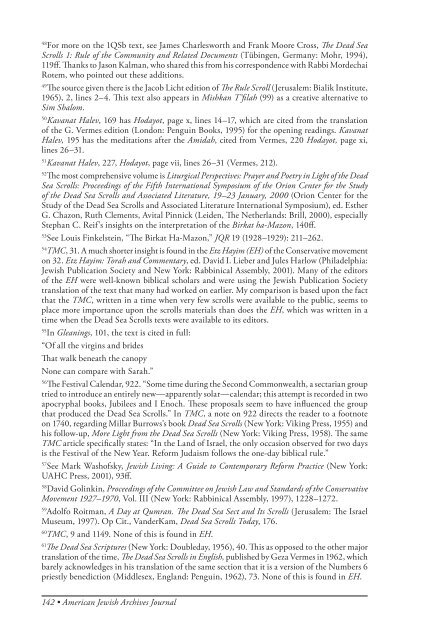The American Jewish Archives Journal, Volume LXI 2009, Number 1
The American Jewish Archives Journal, Volume LXI 2009, Number 1
The American Jewish Archives Journal, Volume LXI 2009, Number 1
Create successful ePaper yourself
Turn your PDF publications into a flip-book with our unique Google optimized e-Paper software.
48For more on the 1QSb text, see James Charlesworth and Frank Moore Cross, <strong>The</strong> Dead Sea<br />
Scrolls 1: Rule of the Community and Related Documents (Tübingen, Germany: Mohr, 1994),<br />
119ff. Thanks to Jason Kalman, who shared this from his correspondence with Rabbi Mordechai<br />
Rotem, who pointed out these additions.<br />
49<strong>The</strong> source given there is the Jacob Licht edition of <strong>The</strong> Rule Scroll (Jerusalem: Bialik Institute,<br />
1965), 2, lines 2–4. This text also appears in Mishkan T’filah (99) as a creative alternative to<br />
Sim Shalom.<br />
50Kavanat Halev, 169 has Hodayot, page x, lines 14–17, which are cited from the translation<br />
of the G. Vermes edition (London: Penguin Books, 1995) for the opening readings. Kavanat<br />
Halev, 195 has the meditations after the Amidah, cited from Vermes, 220 Hodayot, page xi,<br />
lines 26–31.<br />
51Kavanat Halev, 227, Hodayot, page vii, lines 26–31 (Vermes, 212).<br />
52<strong>The</strong> most comprehensive volume is Liturgical Perspectives: Prayer and Poetry in Light of the Dead<br />
Sea Scrolls: Proceedings of the Fifth International Symposium of the Orion Center for the Study<br />
of the Dead Sea Scrolls and Associated Literature, 19–23 January, 2000 (Orion Center for the<br />
Study of the Dead Sea Scrolls and Associated Literature International Symposium), ed. Esther<br />
G. Chazon, Ruth Clements, Avital Pinnick (Leiden, <strong>The</strong> Netherlands: Brill, 2000), especially<br />
Stephan C. Reif’s insights on the interpretation of the Birkat ha-Mazon, 140ff.<br />
53See Louis Finkelstein, “<strong>The</strong> Birkat Ha-Mazon,” JQR 19 (1928–1929): 211–262.<br />
54TMC, 31. A much shorter insight is found in the Etz Hayim (EH) of the Conservative movement<br />
on 32. Etz Hayim: Torah and Commentary, ed. David I. Lieber and Jules Harlow (Philadelphia:<br />
<strong>Jewish</strong> Publication Society and New York: Rabbinical Assembly, 2001). Many of the editors<br />
of the EH were well-known biblical scholars and were using the <strong>Jewish</strong> Publication Society<br />
translation of the text that many had worked on earlier. My comparison is based upon the fact<br />
that the TMC, written in a time when very few scrolls were available to the public, seems to<br />
place more importance upon the scrolls materials than does the EH, which was written in a<br />
time when the Dead Sea Scrolls texts were available to its editors.<br />
55In Gleanings, 101, the text is cited in full:<br />
“Of all the virgins and brides<br />
That walk beneath the canopy<br />
None can compare with Sarah.”<br />
56<strong>The</strong> Festival Calendar, 922. “Some time during the Second Commonwealth, a sectarian group<br />
tried to introduce an entirely new—apparently solar—calendar; this attempt is recorded in two<br />
apocryphal books, Jubilees and I Enoch. <strong>The</strong>se proposals seem to have influenced the group<br />
that produced the Dead Sea Scrolls.” In TMC, a note on 922 directs the reader to a footnote<br />
on 1740, regarding Millar Burrows’s book Dead Sea Scrolls (New York: Viking Press, 1955) and<br />
his follow-up, More Light from the Dead Sea Scrolls (New York: Viking Press, 1958). <strong>The</strong> same<br />
TMC article specifically states: “In the Land of Israel, the only occasion observed for two days<br />
is the Festival of the New Year. Reform Judaism follows the one-day biblical rule.”<br />
57See Mark Washofsky, <strong>Jewish</strong> Living: A Guide to Contemporary Reform Practice (New York:<br />
UAHC Press, 2001), 93ff.<br />
58David Golinkin, Proceedings of the Committee on <strong>Jewish</strong> Law and Standards of the Conservative<br />
Movement 1927–1970, Vol. III (New York: Rabbinical Assembly, 1997), 1228–1272.<br />
59Adolfo Roitman, A Day at Qumran. <strong>The</strong> Dead Sea Sect and Its Scrolls (Jerusalem: <strong>The</strong> Israel<br />
Museum, 1997). Op Cit., VanderKam, Dead Sea Scrolls Today, 176.<br />
60TMC, 9 and 1149. None of this is found in EH.<br />
61<strong>The</strong> Dead Sea Scriptures (New York: Doubleday, 1956), 40. This as opposed to the other major<br />
translation of the time, <strong>The</strong> Dead Sea Scrolls in English, published by Geza Vermes in 1962, which<br />
barely acknowledges in his translation of the same section that it is a version of the <strong>Number</strong>s 6<br />
priestly benediction (Middlesex, England: Penguin, 1962), 73. None of this is found in EH.<br />
142 • <strong>American</strong> <strong>Jewish</strong> <strong>Archives</strong> <strong>Journal</strong>

















